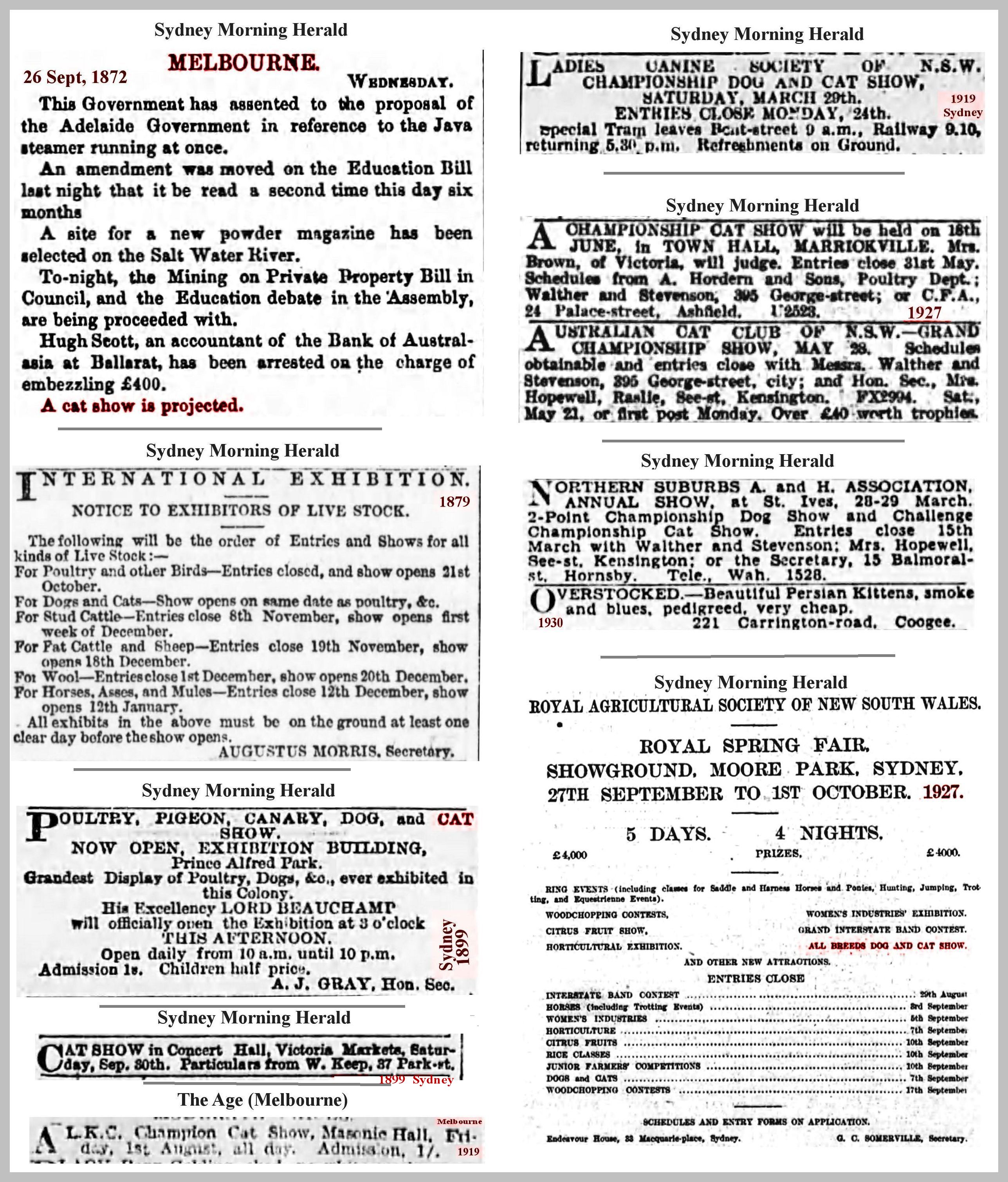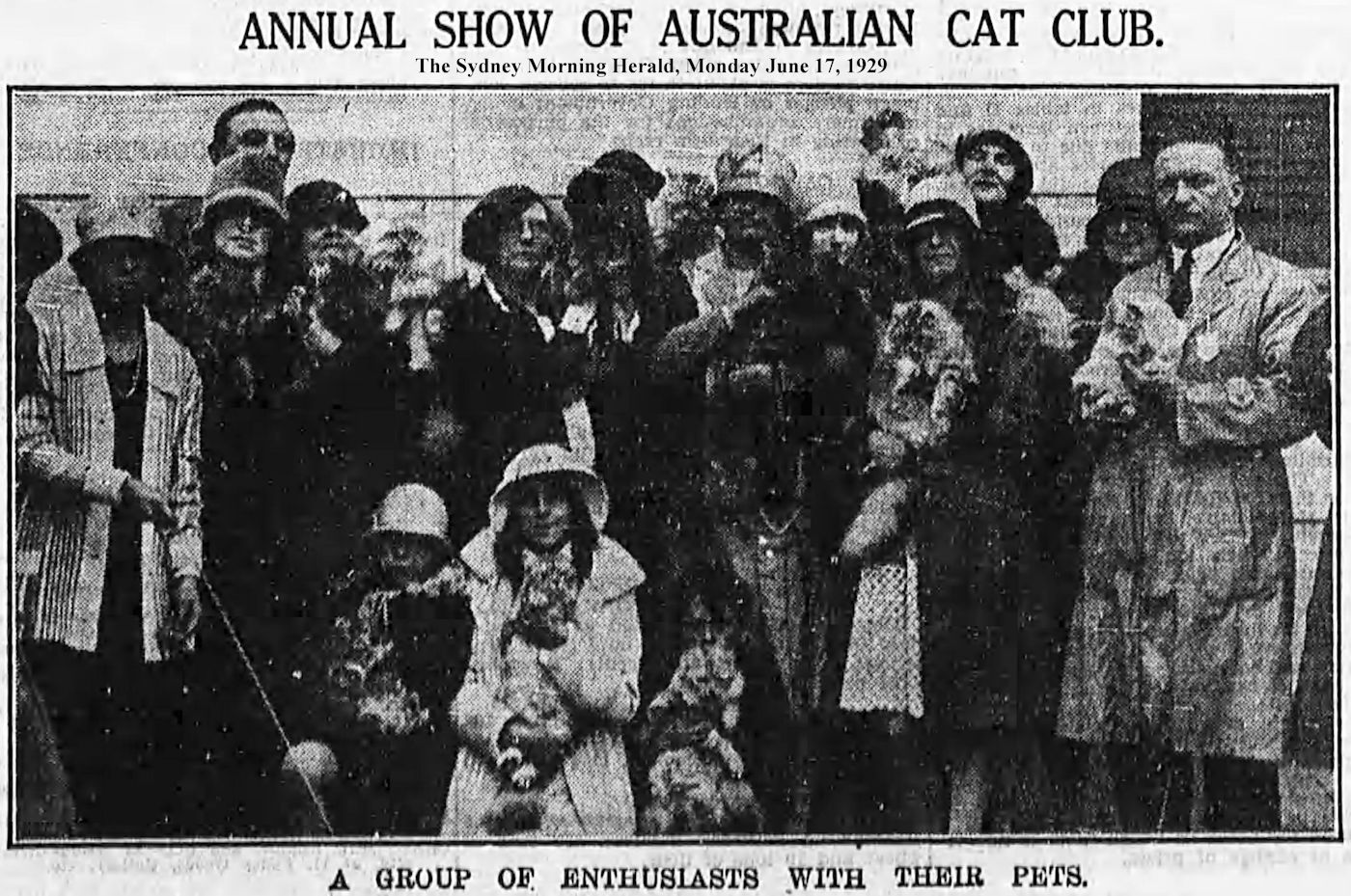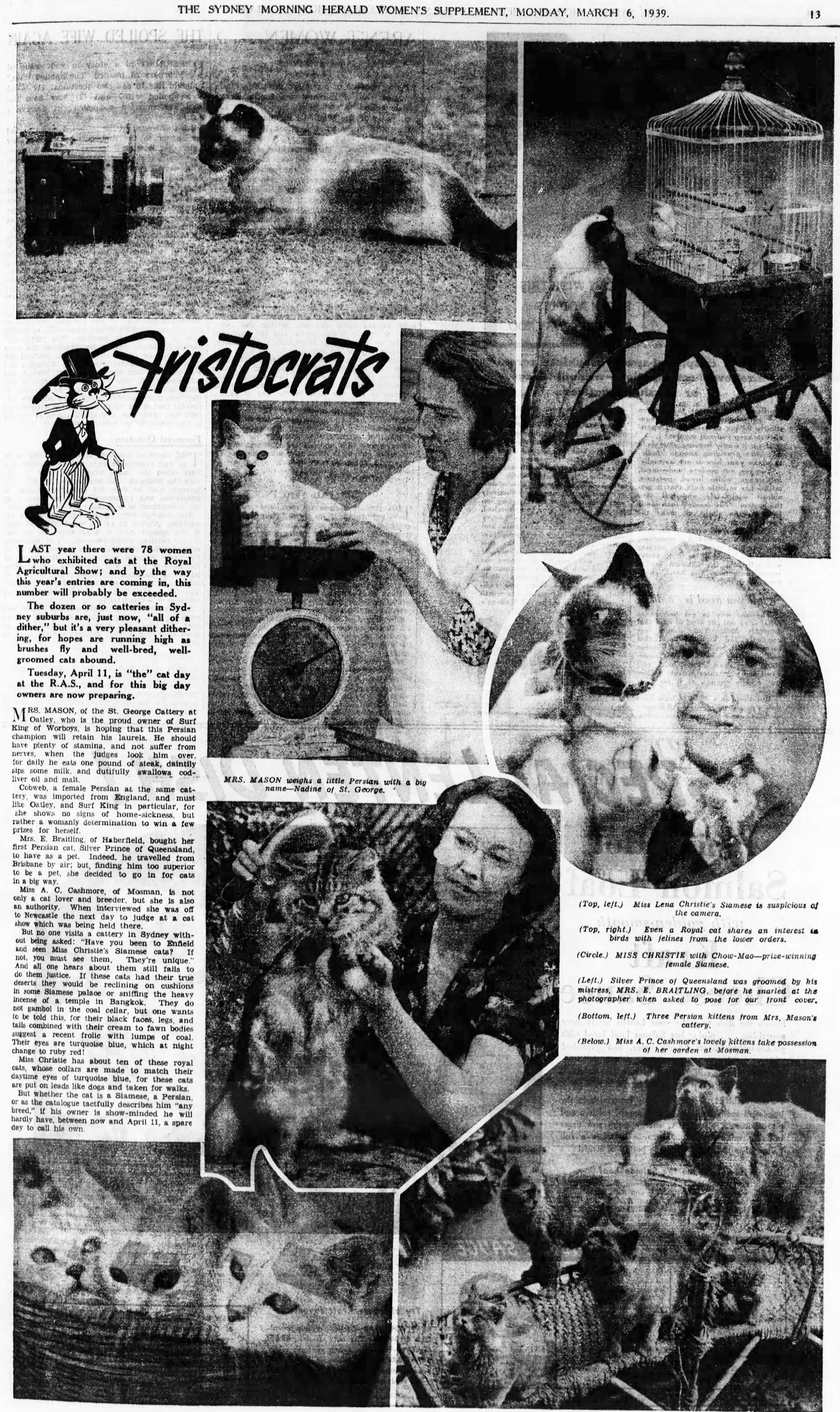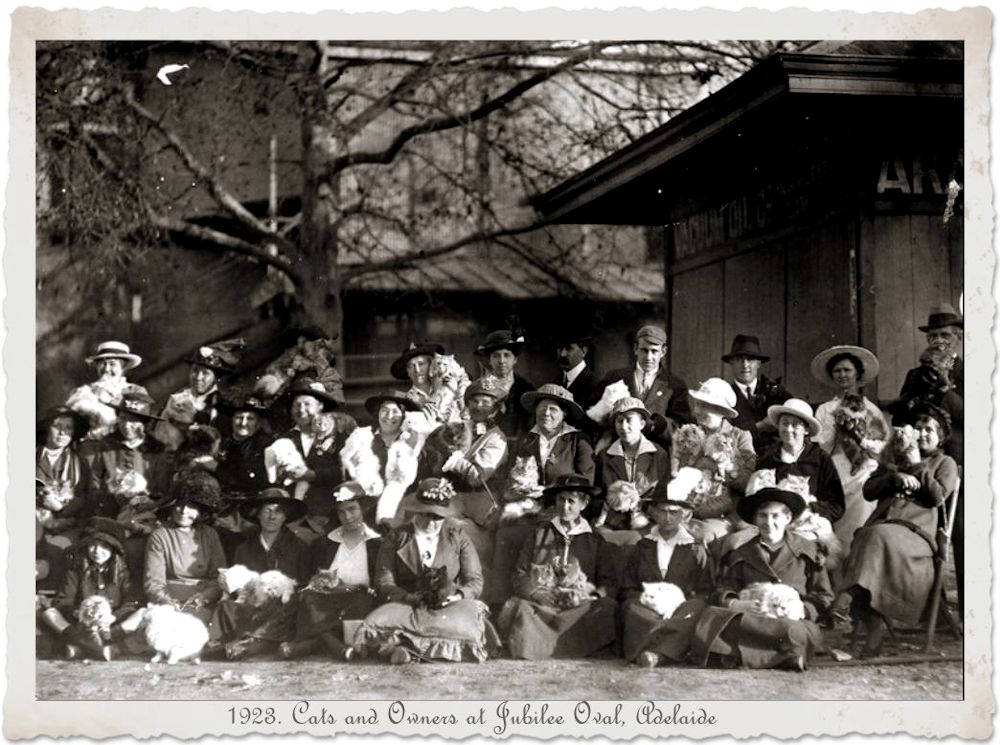
CATS AND THE CAT FANCY IN AUSTRALIA (1880S TO THE EARLY 1900s) - NEWS CUTTINGS

VICTORIA
There were cat shows in Australia in the 19th century as this clipping from the Hamilton Spectator, August 13th, 1872 shows: "We notice, by the Sporting Era, that it is proposed to hold a Cat Show in Melbourne, early in October next, when a solid silver collar, with suitable inscription, will be awarded to every winner."According to The Age, (Melbourne) of 1st February, 1902: “If competition is the soul of trade, it should certainly result in immense improvement among our domestic pets. Here in Melbourne our dogs are far too apt to be “just dog” and our cats “just cat.” And yet, as “horsemen” say, a good looking, well-bred animal costs no more to keep than another. The theory that it is the mongrels that have the brains is long since exploded, and one might just as well expect breeding to count for nothing on the turf as to look for the intelligence of a well-bred dog in every nondescript canine quadruped. Much the same applies to cats, and that the desirability of breeding first class animals is recognised in England is illustrated by the fact that the entries at the last National Cat Show totalled a thousand. Blue Persians formed one of the largest classes, though Siamese and Chinchilla cats were well represented.”
The organised cat fancy in Australia began in 1919 in Victoria and a few years later in New South Wales. However, pedigree cats had been bred in those and other states since at least the 1880s and were being exhibited as sections attached to poultry, dog and rabbit shows and multi-animal shows, often under the umbrella of agricultural shows.
The Australian Cat Club (ACC) was established in Victoria in 1919, but prior to that a cat register was maintained by the Victorian Poultry and Kennel Club (VPKC) as far back as 1885 and possibly earlier. The earliest cat show catalogue known to exist was run by Australian Cat Club in 1912. The ACC register appears to be a continuation of that earlier VPKC register. Until WWI, the ACC was affiliated with the Australian Ladies Kennel Club (ALKC), but by 1925 it was affiliated with the Victorian Kennel Assoc (VKA), which had formed as a breakaway group from the VPKC. There were several other cat registries around and the cat fancy remained fragmented for some time.
SHOW OF PERSIAN CATS. A Fine Display - The Age, Thursday August 5th, 1920: The newly-formed Australian Cat Club, which comprises a large number of lady fanciers, inaugurated their first show of Persian cats on Wednesday at the Independent Hall, Collins-street. The exhibition, which was opened by Sir Henry Weedon, was nicely arranged, and drew a good attendance, and keen interest was centred in the awards. The chief laurels for the best cat in the show were awarded to Mrs. P. Owen, who won with My Digger, a smoke Persian of rare quality. The trophy for the best kitten in the show went to Miss E. Simmonds, with Lord Possie, a true blue Persian, with a magnificent coat. In blue Persians, the championship went to Miss B. Simmonds’s Lord Possie, and Miss D. Dennis's Hawaiian Princess (imp), Black Persian championships fell to Mrs. K. Morris's Duke of Athol and Miss O. M. Bentley's Princess Peggy. In smoke Persians, Mrs. P. Owen’s My Digger and Mrs. W. Sheriff's Beauty took the challenge honors. Other winners were Mrs. H. Hunter, in brown Tabbies; Mrs. R. B. Lemon, with Tawny. Miss E. Stone took the special in Neuters. In Chinchillas Mrs. Charlesworth and Miss F. Laurie won the chief honors. Mrs. M. Wallace and Mrs. V. Springhall scored the championships in shaded silvers. Mrs. Charlesworth and Mrs. H. G. Farrell scored in silver tabby Persians. Mrs. Maher and Mrs. W. Clifford were in front with white Persians. The special prize for the best decorated cage was won by Miss Mills, prettily arranged in various shades of mauve. Afternoon tea was served and musical items were rendered, and the arrangements were well carried out by Mrs. P. Owen, the hon. sec., and an energetic committee of ladies.
In 1928, the ACC organised a meeting for all cat fanciers, held in Melbourne. They proposed forming a "Governing Cat Council" for the whole of the Australian cat fancy (a GCCF). Australia’s GCCF was the third such body to be formed; the two earlier ones being in England and the USA. Judging would become more consistent across the states so that Persians at one end of the country were no longer “years behind” those in Victoria in terms of quality.
In The Australasian (Melbourne, Victoria, 26th Apr 1930, Page 45) the article “CATS IN ENGLAND” compared the English cats to their counterparts in Australia, giving an idea of the state of cat breeding, and the standard of cats, in Australia.
“We are indebted to Mrs. L. C. Ware, of Borzois fame, for the following interesting letter:-
A long day spent at the National Cat Club championship show at Crystal Palace convinces one that it is time we in Victoria scrapped a number of varieties which have long ceased to conform to the standard, either in colour or points. I am thinking more especially of smokes – of which we have none worthy of the name at our Victorian shown. Surely it is time that club secretaries refused to accept entries in this variety, since the cats entered as smokes for many years past have borne but small resemblance to that variety.
Smokes are a lovely breed, and at this show there were good entries of cats of superfine quality. They are black and grey – not the rusty brown so frequently seen at Melbourne shows. This was a two-days’ show – kittens first day only. Entries were large and exhibits of rare quality. One of the outstanding features of the exhibits were the wonderful eyes. Remarking on this to one of the judges, he agreed that the eyes were indeed very fine, but appeared to think that a fetish is being made of eyes to the detriment of other points. Tortoiseshell, tortoiseshell and white, and a number of other colours unknown in Victoria, are exhibited here, and command large entries.
A new breed - to the writer – was the Abyssinian cat, quite a number of these being exhibited. Siamese were also large entries. There are self-coloured reds, and red tabbies. These deep-red tabbies are beautifully marked, some very fine specimens being on view. These are probably the “showiest” variety, for they make a delightful splash of colour. Creams here are very different from those we see exhibited in Victoria under that name. The cream is really a sound coloured biscuit, an exceedingly beautiful and attractive cat. It was a cat of this colour which won supreme honours - repeating former successes – champion of champions, and, judging by the continuous applause which greeted the judge's decision, the award was a very popular one. All were ready to acknowledge the superb quality of this beautiful animal. His wins included 10 specials, five firsts, challenge and best cat in show.
Recalling the time when controversy raged in Victoria as to the correct colour of eyes in white Persians, the writer made inquiries of the judge, and was told that the eyes must be blue. Hazel or orange-coloured eyes are not considered here as show specimens. These huge snow-white cats with their deep cornflower-blue eyes are exceedingly handsome. Blues were both numerous and good. Three wonderful specimens - a male and two females from the same litter – aged about five and a half months, attracted much attention and admiration. They were indeed marvellous specimens and well deserved their many wins, set forth in a bewildering number of cards. Some good silver tabbies were exhibited, but a row of empty cages showed where a number of the best of these should have been on view. Unfortunately, distemper was raging at the time in a number of catteries. For this deadly complaint is - I was informed – very prevalent in England, the complaint having much the same symptoms in cats as in puppies.
Probably the greatest surprise of the show was when the writer came upon the Chinchillas. After inspecting a large number of very lovely cats, quite unlike any I had ever seen before, I made inquiry, “And what breed are these?” “Chinchillas – these are all Chinchillas." Well, of course? But how different in colouring to those I have seen in Victoria. These are so clear and pale in colour that one can only describe them as white - each hair just ticked at the end with black. Their magnificent eyes failed for once to distract one's attention and admiration from their glorious, sparkling coats.
Blacks are here and very fine, with no trace of the rustiness too often seen in this colour at our home shows. And yet I was told that I was not seeing the cats at their best – magnificent though they were – for on account of the exceptionally long, dry summer, coats had not come on quite so well as usual.
The show was held in the concert-room at the Palace. A number of judges officiated – different judges for different colours – but these combined forces when it came to awarding specials, such as “best in show,” &c. Easily accessible throughout the day, they were only too willing to explain to exhibitors just why their exhibit had failed to score. To the overseas visitor they were kindness itself, taking from their cages quite a number of cats which I specially admired, and going over them with untiring patience. A visitor from Australia receives a very frank and warm welcome at English shows, whether in the canine, the cat, or the feathered world. All are deeply interested in Australia.”
The Age (Melbourne), 11 October, 1938 provides us with this short report about a noted Australian cat fancier's investigation into the fancy outside of Australia since British cats were imported into Australia: “In the three years she has been abroad, Mrs. Bruce Pearce has established what surely must be a record. She has made it her business to see “every good cat” in England! A noted fancier - 23 cats at one time is her record to date — she visited every cat show of note while she was away, while her husband judged several of them. Now she has returned with the important news that the Governing Council of Cat Fanciers — that august British body — has "at last" decided to make separate classes at shows for yellow and blue-eyed white Persians — over which in the past controversy has raged bitterly. But for all the immense vogue for "long haireds,” as Persians are now designated, Mrs. Pearce found that Siamese cats threaten to rival their popularity, especially now that Siamese with smoky-blue points are being bred with success. England, by the way, is gaining an enviable reputation for its cats. It is nothing unusual for fanciers to fly from Switzerland, Holland and France to attend the leading shows. And an aristocratic English cat now holds a high position in Italy, for, sold in that country by a friend of Mrs. Pearce, it was bought by an admirer of Mussolini to be presented to no less a personage than Il Duce —who, by the way, is a discerning fancier.”
NEW SOUTH WALES
As with Melbourne, Victoria, there were cat shows in the late 1800s, for example this one reported by the Sydney Morning Herald, 2nd October, 1899: "A cat show in aid of the Civil Ambulance and Transport Brigade was opened on Saturday in the concert-hall of the Victoria Markets, There were over 200 entries from all parts of the country, which created a large amount of interest. All sorts and conditions of cats were shown, from a waif found in Hyde Park to the domestic aristocratic Persian cat of rare value. These costly specimens were in great variety — blue, silver, black, and brown; and as a thoroughly representative exhibition the show was a decided success. The promoters were Mr. and Mrs. Keep, and it is hoped that the interest awakened in the exhibition will lead to the formation of a cat club among fanciers of this universal domestic pet. The exhibits were well staged, and with the aid of an instructive catalogue many visitors, no doubt, learned much of interest concerning the feline race. The judging was performed by Dr. Hughes, Messrs, F. Albert and E. Butcher."
Attitudes to cat shows are alluded to in the The Sydney Morning Herald, 15th August, 1901, [The Mayor] considered it a great privilege for Messrs. Gollin to have asked him as Mayor of the city to declare the building open. In the past the Mayor had generally been kept aside for the opening of nothing more important than a dog show – (laughter) – and sometimes a canary exhibition. In fact he had been asked to open a cat show. He drew the line at that. He did not mind going to the dogs – (laughter) – but he stopped at the cats.
The New South Wales (NSW) organised cat fancy started up a couple of years after Victoria (usually stated as 1925). The first formal "Kitten Parade" in NSW was held in 1924 under the auspices of the Poultry Club of NSW, but Persian cats had already been exhibited in cat classes at dog shows in NSW back in 1908 and I found this news report from 1904:
”Poultry, Pigeon, Dog, And Cat Show” – The Sydney Morning Herald, 27th June, 1904. The 27th annual show of the New South Wales Poultry, Pigeon, Canary, and Dog Society was brought to a close on Saturday evening at the Exhibition Building. [. . .] A number of additional awards were made on Saturday, including the judging by Mr. C. W. Gray of the cats section, in which the number of entries was hardly up to the usual. The following awards were announced:—Cats:
Black female: Mrs. C, Butcher, First.
White Female: Minnie A. Sutton, First.
Isle of Man (Manx) – Male or Female: Miss Nira Towns, Champion and First.
Persian: Mrs. J.T. Claeson and Miss Emmie Jennings, equal First; Miss Muriel Jennings, Second; Mrs. Fenning, Third.
Any Other Variety – Cat, gelded: Mrs. F. Goodhead, First.
Shorthair kitten, any colour, under 9 months: Mrs. C, Butcher, First.
Heaviest Cat, any variety, male or female: Mrs. F. Goodhead, First.”
The "Australasian Farm & Field & Poultry Advocate" had reported on the cat section at the Poultry Club of NSW in June 1923, at which around 50 cats were exhibited, so there was evidently an established cat fancy albeit not yet under the auspices of a specialist Cat Club or registry. The Poultry Club seems to have held cat sections at all its shows and in 1924 exhibitors requested that the club send a letter to the Royal Agricultural Society requesting a cat section in the RAS schedule.

And this article (“Aristocrats”) from The Sydney Morning Herald Women’s Supplement, March 6, 1939 gives more details about several prominent exhibitors of the time. Last year there were 78 women who exhibited cats at the Royal Agricultural Show; and by the way this year’s entries are coming in, this number will probably be exceeded. The dozen or so catteries in Sydney suburbs are, just now, “all of a dither,” but it’s a very pleasant dithering, for hopes are running high as brushes fly and well-bred, well-groomed cats abound. Tuesday, April 11, is “the” cat day at the R.A.S., and for this big day owners are now preparing.
Mrs. Mason, of the St. George Cattery at Oatley, who is the proud owner of Surf King of Worboys, is hoping that this Persian champion will retain his laurels. He should have plenty of stamina, and not suffer from nerves, when the Judges look him over, for daily he eats one pound of steak, daintily sips some milk, and dutifully swallows cod-liver oil and malt. Cobweb, a female Persian at the same cattery, was imported from England, and must like Oatley, and Surf King in particular, for she shows no signs of home-sickness, but rather a womanly determination to win a few prizes for herself.
Mrs. E. Braitling, of Haberfleld, bought her first Persian cat, Silver Prince of Queensland, to have as a pet. Indeed, he travelled from Brisbane by air; but, finding him too superior to be a pet, she decided to go in for cats in a big way. Miss A. C. Cashmore, of Mosman, is not only a cat lover and breeder, but she is also an authority. When interviewed she was off to Newcastle the next day to judge at a cat show which was being held there.
But no one visits a cattery in Sydney without being asked: “Have you been to Enfield and seen Miss Christie's Siamese cats? If not, you must see them. They’re unique,” And all one hears about them still falls to do them justice. If these cats had their true deserts they would be reclining on cushions in some Siamese palace or sniffing the heavy incense of a temple in Bangkok. They do not gambol in the coal cellar, but one wants to be told this, for their black faces, legs, and tails combined with their cream to fawn bodies suggest a recent frolic with lumps of coal. Their eyes are turquoise blue, which at night change to ruby red!
Miss Christie has about ten of these royal cats, whose collars are made to match their daytime eyes of turquoise blue, for these cats are put on leads like dogs and taken for walks. But whether the cat is a Siamese, a Persian, or as the catalogue tactfully describes him “any breed,” if his owner is show-minded he will hardly have, between now and April 11, a spare day to call his own.

This excerpt from a "Report From Australia" in Jan 1950 "Our Cats" by Mr Harry H Wynne, (Joint Publicity Officer of Royal Agricultural Society Cat Club, N.S.W.) mentions the progress being made since the 1930s: "For a considerable number of years the Cat Fancy in Australia (particularly in New South Wales) has progressed quietly and without fanfare, and although we may be a long way behind England and America with regard to quantity, we are definitely on equal terms in quality. Two decades ago we adopted a standard which very closely resembled the English ideals and which, with local adaptation to suit our very different climate, has invariably ensured a high-class animal. As in other lands, our felines suffered during the war years, but are rapidly overcoming the inevitable setbacks, and indeed the Fancy is now approaching the flourishing stage. It is significant that many of our top-line breeders are again casting wistful glances at English catalogues, for, undoubtedly, our foremost stock are direct descendants from overseas importation and our native crossings are not as varied as could be desired."
One of its founders, Mr E J Lonsdale was still an active member into the 1950s. Although he retired from the Fancy in 1938, he was induced to return in 1947 and he visited a number of English shows and English catteries during 1950. Another foundation member was Mr Fred Pearce, who was still a judge in the 1950s - 28 years of service, interrupted only by war-time service. Mr Pearce became senior Vice-President and judged cats in Australia and New Zealand. The club had seven life members by 1953: Mr Lonsdale (1940); Mr Pearce (1942); Mr Harry Wynne (1947); Mr and Mrs Harvey (1952); Miss A Cashmore and Mrs Wallace (1953). During its first three decades, the Association had held shows in diverse venues: Mr Lonsdale's front lawn town halls, sections of agricultural shows (where the cats might have to share the hall with sheep) and eventually at the NSW Sheepbreeders' Association Annual Show outside Sydney.
SOUTH AUSTRALIA, WESTERN AUSTRALIA, QUEENSLAND, TASMANIA AND NORTHERN TERRITORY
The earliest reference to South Australia's fancy appears to be Persians being exhibited in 1908. By 1924, more than 160 Persians were exhibited at a show (Australian Farm & Field & Poultry Advocate) and the "Australian Rabbit & Pigeon Journal" featured a "Cat Chat" column edited by a South Australian cat fancier.

In Western Australia, a Persian was exhibited at some sort of show in Perth in 1896. The organised cat fancy in that state was established during the 1920s. It seems that cats lagged behind in terms of quality for a number of years as according to the above-mentioned "Cat Chat" column in 1933, Persians had improved greatly in the preceding 4 or 5 years and some were fit to compete against those in the Eastern states. It also seems that judges were not rigorous enough, which was holding the cats back in terms of quality.
Persians were being imported into Tasmania by a Mrs Cameron in 1901, and they were probably being bred in Queensland prior to 1910. Blue Persians and chinchillas were present in Tasmania in the 1920s. Pedigree cats were sometimes exhibited at agricultural shows in Tasmania and Queensland, prior to the establishment of an organised cat fancy in the 1960s. Siamese cats had arrived in Tasmania in or before 1925, with one featuring on newsreel filmed at the Deloraine races that year. The Queensland fancy evolved in the 1930s with cats initially being exhibited at bird shows and other animal shows.
Breeding and exhibition of fancy cats in the Northern Territory came much later than in the other states. That region was settled later by Europeans and was geographically more isolated.